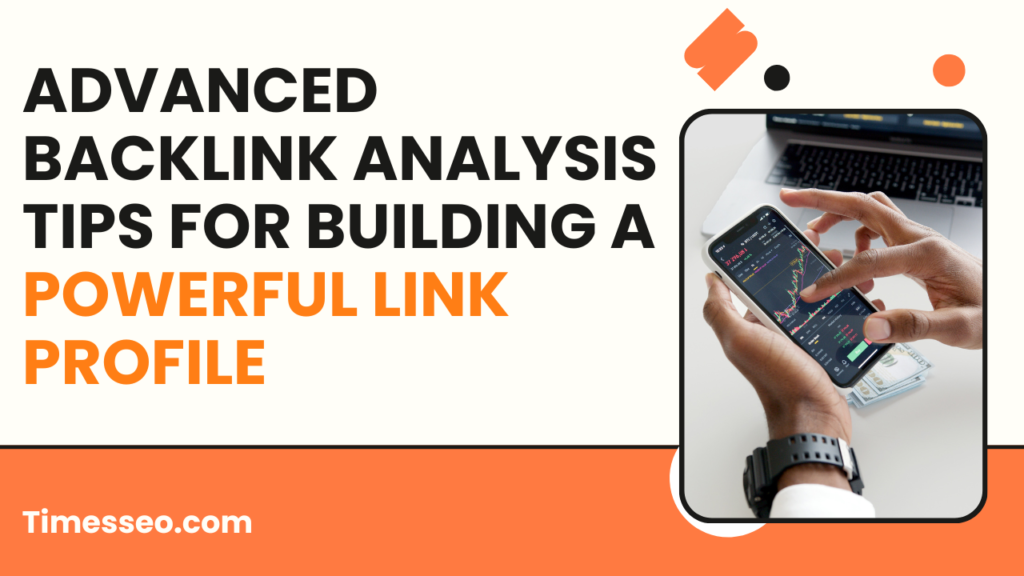
Advanced Backlink Analysis Tips for Building a Powerful Link Profile
Unlock the secrets to a stronger SEO strategy with our blog post “Advanced Backlink Analysis Tips for Building a Powerful Link Profile.” This in-depth guide covers expert-level strategies for auditing, optimizing, and strengthening your backlink profile using cutting-edge tools and techniques. Whether you’re cleaning up toxic links or spying on competitors, these advanced backlink analysis tips will help you boost your domain authority, improve search rankings, and build a healthier, more effective link strategy.
Table of Contents
Introduction
Backlinks from other websites are similar to endorsements. They tell search engines that your content is worth referencing, which in turn boosts your site’s visibility and ranking. Backlink analysis is useful because not all backlinks are made equal.
If you want a powerful link profile that works for your SEO instead of against it, you need to go beyond just building links. You need to analyze, optimize, and strategically improve your backlink game. Let’s dive deep.
Understanding the Basics
Difference Between Good and Bad Backlinks
Reputable, pertinent, and authoritative websites provide high-quality backlinks. They’re placed in meaningful content, ideally with natural anchor text.
Bad backlinks? They’re usually from spammy, unrelated, or low-quality sites—and they can tank your rankings if Google catches on.
Types of Backlinks That Influence Ranking
- Editorial Links – earned through great content.
- Guest Post Links – controlled and placed by you.
- Niche Edits – inserted into existing content.
- Profile Links – from online profiles.
- Forum and Comment Links – lower value but helpful if used right.
Key Metrics to Evaluate Backlinks
- Domain Authority (DA)
- Page Authority (PA)
- Trust Flow & Citation Flow
- Anchor Text Diversity
- Link Relevance
Why Backlink Analysis Matters
Role of Backlinks in Google’s Algorithm
Backlinks remain one of the top three ranking factors in Google’s algorithm. The quality and relevance of these links tell search engines whether your site deserves a top spot or not.
Impact on Domain Authority and Trust Flow
Your backlink profile directly affects how authoritative your site appears. A strong, clean link profile = high DA = higher rankings and better visibility.
Tools You Need for Advanced Backlink Analysis
Ahrefs
Ahrefs gives you deep insight into your backlink data, including referring domains, anchor text, link type, and more.
SEMrush
Best for competitive backlink analysis and link audits. It’s perfect for finding toxic links and monitoring new or lost backlinks.
Moz Link Explorer
Easy-to-use for quick checks on Domain Authority and Page Authority.
Google Search Console
Free and accurate—but limited. It tells you who’s linking to you and allows disavow submissions.
Free Tools Worth Trying
- Ubersuggest
- Neil Patel Backlink Checker
- SEO SpyGlass (by SEO PowerSuite)
How to Perform an Effective Backlink Audit
Step-by-Step Process
Export Your Current Backlink Profile
Start by downloading your full backlink list using Ahrefs or Google Search Console.
Identify Toxic Links
Look for:
- Links from spammy or adult sites
- Over-optimized anchor text
- Irrelevant niche domains
Analyze Anchor Texts
Make sure you’re not overusing exact-match keywords.
Understand Link Context
Is your link placed naturally within content? Or was it simply thrown in the footer?
Identifying and Removing Harmful Backlinks
What Makes a Link Toxic?
- Low domain trust
- Irrelevant topics
- Suspicious link patterns
- Links from link farms or PBNs
Disavow Tool: Use it Wisely
Google’s Disavow Tool can help protect your site from bad links, but it’s not to be used casually.
Manual Removal vs Disavow
If you can, reach out and ask for link removal first. Disavow only when it’s impossible.
Competitive Backlink Analysis
How to Spy on Competitors’ Link Profiles
Use tools like SEMrush and Ahrefs to extract the backlinks of your top-ranking competitors.
What You Can Learn from Competitor Links
- Which blogs link to them?
- What content earned the links?
- What anchor texts are used?
Replicating Their Best Links
If they got featured on a blog or did a guest post, you can pitch to the same sites with even better content.
Link Gap Analysis
Discover Missed Opportunities
Compare your backlink profile with competitors to spot links they have that you don’t.
Tools to Identify Link Gaps
- Ahrefs’ Link Intersect Tool
- SEMrush Backlink Gap Tool
Anchor Text Optimization
Types of Anchor Text
- Exact match
- Partial match
- Branded
- Generic (“click here”)
- Naked URL
Common Mistakes to Avoid
- Over-optimizing with keyword-rich anchors
- Repeating the same anchor text too often
Ideal Distribution Strategy
Keep it organic: 30% of URLs are branded, 30% are generic, 20% are partial matches, 10% are precise matches, and 10% are naked.
Contextual and Niche-Relevant Backlinks
Why Relevance Matters More Than Quantity
10 links from relevant sites beat 100 irrelevant ones. Relevance helps you rank faster and safer.
How to Earn Contextual Links Naturally
- Publish high-quality content
- Guest post on niche blogs
- Build authority in your domain
Evaluating Link Velocity and Link Growth
Understanding Natural Link Acquisition Patterns
Gradual growth = natural. Sudden spikes = red flag for Google.
Avoiding Suspicious Growth Patterns
Don’t build too many links too fast, especially exact-match anchors.
Backlink Diversification Strategies
Editorial Links vs Profile Links
Editorial links carry more weight. But a diversified profile adds credibility.
Forums, Blogs, and PR – Finding Balance
Mix up where your links come from to avoid patterns and increase trust.
Building Relationships for Better Links
Outreach That Works
Send personalized, value-driven emails. Don’t beg for a backlink—offer value.
How to Pitch Value, Not Just a Link
Give them a reason to link—unique stats, visuals, expert insight, or a fresh angle.
Tracking Backlink Performance Over Time
Metrics to Watch
- Number of referring domains
- New vs lost backlinks
- DA/PA growth
- SERP movement
Signs Your Link Profile is Improving
- Increased organic traffic
- Higher keyword rankings
- Better crawl rate
Common Mistakes in Backlink Analysis
Relying Only on One Tool
Every tool has blind spots—combine data from multiple sources.
Ignoring Link Context and Relevance
Not all links are good—even from high DA sites. Relevance is king.
Conclusion
Backlink analysis isn’t just a task—it’s a strategy. By digging deep into the quality, source, context, and performance of your links, you’re not just cleaning house—you’re building a fortress.
Remember: It’s not about how many links you have, it’s about what kind of links you build. Stay relevant, stay ethical, and always aim for long-term growth.
Frequently Asked Questions
Ahrefs is widely regarded as the most comprehensive tool, but SEMrush and Moz are also excellent.
At least once every quarter. If you're running aggressive link campaigns, do it monthly.
Yes, toxic links can lead to penalties or ranking drops if left unchecked.
By creating link-worthy content, engaging in outreach, and offering value through partnerships or guest posts.
It’s risky. Google discourages paid links. Focus on building relationships and content that earns links naturally.
Table of Contents
Popular Posts
-
 Affordable Technical SEO Audit for Small Business: A Complete Guide26 Jun 2025 Blog
Affordable Technical SEO Audit for Small Business: A Complete Guide26 Jun 2025 Blog -
 How to Get an Affordable Technical SEO Audit for Small Business27 Jun 2025 Blog
How to Get an Affordable Technical SEO Audit for Small Business27 Jun 2025 Blog -
 The Ultimate Local SEO Audit Checklist for Startups28 Jun 2025 Blog
The Ultimate Local SEO Audit Checklist for Startups28 Jun 2025 Blog -
 Local SEO Audit Checklist for Startups: A Beginner’s Guide28 Jun 2025 Blog
Local SEO Audit Checklist for Startups: A Beginner’s Guide28 Jun 2025 Blog -
 Top On-Page SEO Audit Steps for Service Websites Every Business Should Know29 Jun 2025 Blog
Top On-Page SEO Audit Steps for Service Websites Every Business Should Know29 Jun 2025 Blog -
 Technical SEO for WordPress: The Ultimate Beginner’s Guide01 Jul 2025 Blog
Technical SEO for WordPress: The Ultimate Beginner’s Guide01 Jul 2025 Blog -
 The Impact of On-Page SEO Audit Steps for Service Websites on UX01 Jul 2025 Blog
The Impact of On-Page SEO Audit Steps for Service Websites on UX01 Jul 2025 Blog -
 Technical Mobile SEO Audit Tips for Developers02 Jul 2025 Blog
Technical Mobile SEO Audit Tips for Developers02 Jul 2025 Blog -
 Complete SEO Backlink Audit Guide for Better Google Rankings03 Jul 2025 Blog
Complete SEO Backlink Audit Guide for Better Google Rankings03 Jul 2025 Blog -
 Boost Your Rankings with Technical SEO for WordPress01 Jul 2025 Blog
Boost Your Rankings with Technical SEO for WordPress01 Jul 2025 Blog






